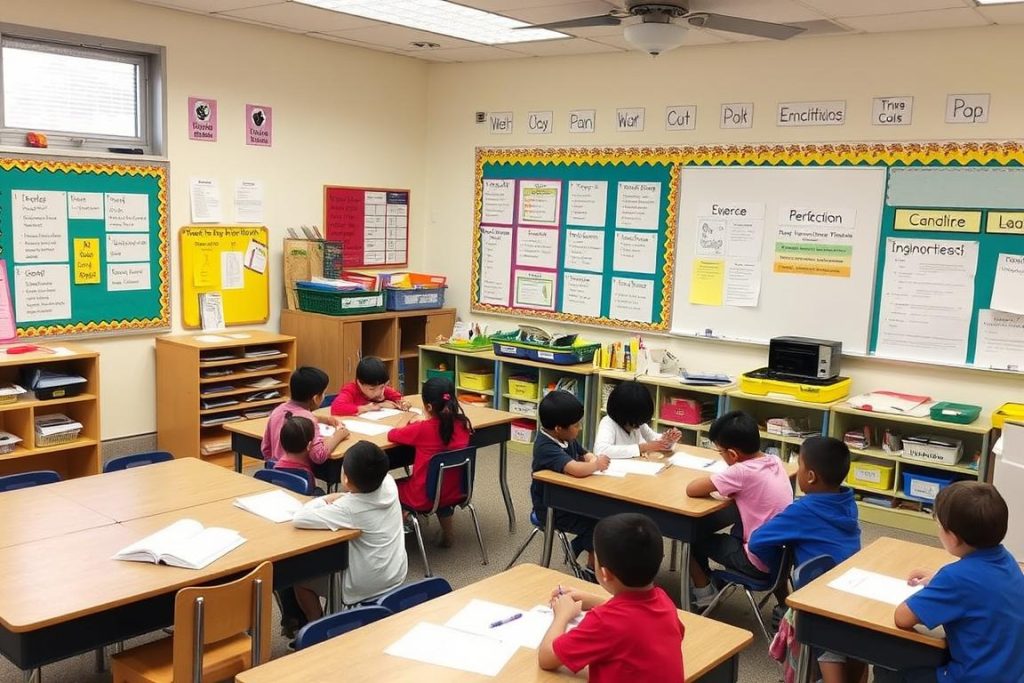Why Student Choice Matters in Differentiated Classrooms
Implementing student choice isn’t just about letting students do whatever they want. It’s a strategic approach that acknowledges the diverse ways students learn and process information. When students have agency in their learning journey, they become more invested in the outcome.
Research consistently shows that when students have choices, their motivation and engagement increase significantly. According to a study highlighted by Edutopia, students who have input into their learning experience demonstrate greater persistence when facing challenges and develop stronger critical thinking skills.
Benefits for Students
- Increased motivation and engagement
- Development of decision-making skills
- Greater ownership of learning
- Improved self-regulation
- Higher academic achievement
Benefits for Teachers
- Natural differentiation without creating multiple lesson plans
- Better classroom management through engagement
- Deeper insights into student interests and abilities
- More authentic assessment opportunities
- Increased student independence
By incorporating student choice into your classroom, you’re not just differentiating instruction—you’re creating a learning environment that respects students as individuals with unique strengths, interests, and needs.
Ready to transform your classroom with differentiation strategies?
Discover proven techniques to implement effective differentiation through student choice.
Practical Student Choice Strategies for Everyday Teaching
Implementing student choice doesn’t require a complete overhaul of your teaching approach. Start small with these practical strategies that you can incorporate into your existing lessons:
1. Choice Boards
Choice boards (also called learning menus) offer students a selection of activities that all target the same learning objective. Create a tic-tac-toe style board with nine different activities that appeal to different learning styles and interests.
For example, in a science unit on ecosystems, options might include:
- Create a diagram of a food web
- Write a story from the perspective of an animal in the ecosystem
- Build a 3D model of the ecosystem
- Record a podcast explaining the ecosystem’s components
- Research and present on how climate change affects the ecosystem
2. Project Format Options
When assigning projects, allow students to choose how they’ll demonstrate their learning:
Written Options
- Essay
- Research paper
- Children’s book
- Journal entries
- News article
Visual Options
- Poster
- Infographic
- Comic strip
- Video
- Slideshow
Interactive Options
- Presentation
- Debate
- Demonstration
- Game creation
- Teaching a mini-lesson
3. Reading Choice
Offer a selection of texts at different reading levels that all address the same topic or theme. Students can choose based on their interest and reading ability, while still participating in whole-class discussions about the central concepts.
4. Learning Station Rotation
Create different stations around the classroom that approach the same concept through different modalities. Allow students to choose which stations to visit and in what order, ensuring they complete a minimum number during the lesson.
Remember that student choice works best when options are carefully designed to meet learning objectives while accommodating different learning preferences. The goal isn’t to create more work for yourself, but to provide meaningful pathways for all students to succeed.

Implementing Student Choice in Assessment
Assessment is another powerful area where student choice can enhance differentiation. When students have options for demonstrating their knowledge, they can showcase their learning in ways that play to their strengths.
“Assessment should not just measure learning—it should promote it. When we offer students choice in assessment, we acknowledge that there are multiple valid ways to demonstrate understanding.”
— Carol Ann Tomlinson, Differentiation Expert
Assessment Choice Strategies
Formative Assessment Options
- Exit ticket options (written, verbal, or visual)
- Self-assessment checklists
- Choice of practice problems
- Digital or analog response methods
- Peer teaching as demonstration of understanding
Summative Assessment Options
- Portfolio of work with reflection
- Traditional test with choice of questions
- Project with format options
- Demonstration or performance
- Oral examination or presentation
When implementing assessment choice, it’s crucial to maintain consistent standards across all options. Create clear rubrics that evaluate the same learning objectives regardless of the format students choose.
Teacher Tip:
Start small with assessment choice. Try offering two options for your next assessment before expanding to more choices. This allows you to manage the logistics while students become familiar with making meaningful choices about their learning.
By incorporating student choice into your assessment practices, you gain valuable insights into how your students learn best while giving them the opportunity to demonstrate their knowledge in authentic ways.
Looking for more differentiation strategies?
Access our comprehensive resources to implementing effective differentiation in your classroom.
Managing Student Choice Without Chaos
One common concern about implementing student choice is that it might lead to classroom management challenges. However, with thoughtful planning and clear structures, student choice can actually improve behavior and engagement.

Strategies for Structured Choice
Clear Expectations
Post visual guides that outline what successful work looks like for each choice option. Provide exemplars when possible.
Consistent Routines
Establish predictable procedures for making choices, transitioning between activities, and seeking help when needed.
Thoughtful Grouping
Consider whether choices will be completed individually, with partners, or in small groups based on learning objectives.
Scaffolding Choice for All Learners
Not all students are equally prepared to make effective choices about their learning. Some may need additional support:
- For students who struggle with decisions: Start with limited options (2-3 choices) and gradually increase as they build confidence.
- For students who rush through work: Include quality checkpoints before they can move to a new choice.
- For students who need more structure: Provide planning templates that help them map out their approach to each choice.
- For advanced learners: Include extension options that allow for greater depth and complexity.
Reflection Questions for Teachers
As you implement student choice, regularly ask yourself:
- Are my choices meaningful and aligned with learning objectives?
- Do the options accommodate different learning preferences?
- Is there an appropriate balance between structure and autonomy?
- How am I supporting students who struggle with making choices?
- What evidence shows that choices are enhancing learning?
Remember that implementing student choice is a learning process for both you and your students. Start small, reflect often, and adjust as needed based on what works in your unique classroom context.
Student Choice Success Stories from Real Classrooms
Seeing student choice in action can provide valuable inspiration for your own classroom. Here are real examples from teachers who have successfully implemented choice-based differentiation:
Elementary Example: Math Workshop
Ms. Rodriguez, a 3rd-grade teacher, transformed her math instruction by creating a workshop model with different stations:
- Teacher-led small group instruction
- Hands-on manipulative activities
- Digital practice with immediate feedback
- Real-world problem-solving challenges
- Math games reinforcing key concepts
Students rotate through required stations and then choose from optional stations based on their interests and needs. Ms. Rodriguez reports higher engagement and improved test scores since implementing this approach.
Middle School Example: Literature Circles
Mr. Washington’s 7th-grade language arts class uses literature circles where students choose:
- Which book to read from a curated selection
- Which role to take in discussions (discussion director, passage picker, word wizard, etc.)
- How to present their final book project
He notes that students who previously disliked reading are now actively participating and completing books, while advanced readers are challenging themselves with more complex texts.

High School Example: Science Inquiry Projects
Ms. Patel’s biology class implements choice through guided inquiry projects where students:
- Choose a research question within curriculum parameters
- Design their own experiment methodology
- Select appropriate data collection tools
- Determine how to present and analyze findings
She found that this approach not only improved content understanding but also developed crucial scientific thinking skills and increased student investment in the learning process.
These success stories highlight a common theme: when teachers thoughtfully implement student choice, they create learning environments where students thrive academically and develop greater independence.
Want to implement these strategies in your classroom?
Get access to ready-to-use templates, lesson plans, and professional development resources.
Getting Started with Student Choice Tomorrow
You don’t need to revolutionize your classroom overnight to begin implementing student choice. Start with these simple steps:
Step 1: Identify One Lesson
Choose an upcoming lesson that could benefit from more student engagement. Look for content that could be approached in multiple ways while still meeting the same learning objective.
Step 2: Create 2-3 Options
Design a few different ways students could practice or demonstrate their learning. Keep it simple—even offering a choice between two activities is a great start.
Step 3: Establish Clear Guidelines
Create simple instructions for each option, including what success looks like and how students should submit their work.

Quick-Start Choice Activities
Here are some easy ways to incorporate student choice into your existing lessons:
- Think-Pair-Share Choice: Give students 2-3 prompts to choose from for discussion.
- Homework Choice Boards: Create a simple grid with 4-6 practice activities and let students choose which to complete.
- Seating Choice: Designate different areas for different types of work (quiet independent work, collaborative space, etc.).
- Assessment Format: Allow students to choose between written, visual, or oral responses for exit tickets.
- Practice Method: Offer options for how students practice new skills (digital app, worksheet, peer teaching, etc.).
Remember:
All choices should be equally valuable for learning. Avoid creating a situation where one option is clearly more appealing or easier than others, as this defeats the purpose of meaningful choice.
As you become more comfortable with student choice, you can gradually expand the options and areas where you implement choice-based learning. The key is to start small, reflect on what works, and build from there.
Ready to take your teaching to the next level?
Explore our comprehensive resources for implementing effective differentiation strategies.
Conclusion: The Power of Student Choice
Implementing student choice is one of the most effective ways to differentiate instruction without creating an unsustainable workload. By thoughtfully designing options that address the same learning objectives through different pathways, you create a classroom where all students can thrive.
Remember that offering choice isn’t about letting students do whatever they want—it’s about providing structured options that honor their learning preferences while maintaining high expectations. When students feel that their preferences and strengths are valued, they become more engaged, motivated, and successful learners.
As you incorporate student choice into your teaching practice, you’ll likely discover that your students surprise you with their creativity, insight, and capacity for self-direction. You’ll also find that differentiation becomes a natural part of your teaching rather than an additional burden.

Start small, be consistent, and watch as student choice transforms your classroom into a more dynamic, inclusive, and effective learning environment. Your students—and your teacher satisfaction—will thank you for it.
Ready to transform your teaching with differentiation strategies?
Access our complete library of resources, templates, and professional development materials.




